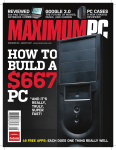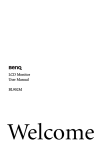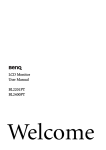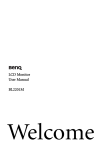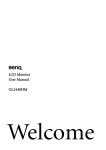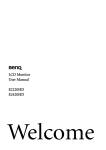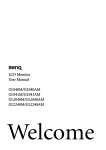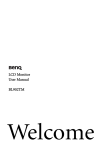Download BenQ XL2410T User manual
Transcript
LCD Monitor User Manual XL2410T Welcome Copyright Copyright © 2010 by BenQ Corporation. All rights reserved. No part of this publication may be reproduced, transmitted, transcribed, stored in a retrieval system or translated into any language or computer language, in any form or by any means, electronic, mechanical, magnetic, optical, chemical, manual or otherwise, without the prior written permission of BenQ Corporation. Disclaimer BenQ Corporation makes no representations or warranties, either expressed or implied, with respect to the contents hereof and specifically disclaims any warranties, merchantability or fitness for any particular purpose. Further, BenQ Corporation reserves the right to revise this publication and to make changes from time to time in the contents hereof without obligation of BenQ Corporation to notify any person of such revision or changes. Please follow these safety instructions for best performance, and long life for your monitor Power Safety • The AC plug isolates this equipment from the AC supply. • The power supply cord serves as a power disconnect device for pluggable equipment. The socket outlet should be installed near the equipment and be easily accessible. • This product should be operated from the type of power indicated on the marked label. If you are not sure of the type of power available, consult your dealer or local power company. • An approved power cord greater or equal to H03VV-F or H05VV-F, 2G or 3G, 0.75mm2 must be used. Care And Cleaning • Cleaning. Always unplug your monitor from the wall outlet before cleaning. Clean the LCD monitor surface with a lint-free, non-abrasive cloth. Avoid using any liquid, aerosol or glass cleaners. • Slots and openings on the back or top of the cabinet are for ventilation. They must not be blocked or covered. Your monitor should never be placed near or over a radiator or heat source, or in a built-in installation unless proper ventilation is provided. • Never push objects or spill liquid of any kind into this product. Servicing Do not attempt to service this product yourself, as opening or removing covers may expose you to dangerous voltages or other risks. If any of the above mentioned misuse or other accident such as dropping or mishandling occurs, contact qualified service personnel for servicing. Table of Contents Copyright .......................................................................................................................... 2 Disclaimer ......................................................................................................................... 2 Getting started .................................................................................................................. 4 Getting to know your monitor ........................................................................................ 6 Front view ........................................................................................................................................6 Back view .........................................................................................................................................6 How to assemble your monitor hardware ...................................................................... 7 Adjusting the monitor stand height .............................................................................................11 Rotating the monitor ....................................................................................................................12 Viewing angle adjustment .............................................................................................................13 How to detach the stand base .......................................................................................................13 Using the monitor wall mounting kit ..........................................................................................14 Getting the most from your BenQ monitor ................................................................. 15 How to install the monitor on a new computer ..........................................................................16 How to upgrade the monitor on an existing computer ..............................................................17 How to install on Windows 7 system ...........................................................................................18 How to install on Windows Vista systems ...................................................................................19 How to install on Windows XP system ........................................................................................20 How to watch 3D content on your monitor ................................................................................21 Picture optimization ...................................................................................................... 22 How to adjust your monitor .......................................................................................... 23 The control panel ..........................................................................................................................23 Hot key mode ................................................................................................................................24 Main menu mode ..........................................................................................................................25 Troubleshooting ............................................................................................................. 39 Frequently asked questions (FAQ) ...............................................................................................39 Need more help? ............................................................................................................................40 1. Getting started When unpacking please check you have the following items. If any are missing or damaged, please contact the place of purchase for a replacement. BenQ LCD Monitor Monitor Base Quick Start Guide Manual CD NVIDIA Driver CD Power Cord (Picture may differ from product supplied for your region.) 4 Getting started Video Cable: D-Sub Video Cable: DVI-D Dual Link Video Cable: HDMI (Optional accessory for models with HDMI inputs, sold separately) Mouse (Optional) Mouse pad (Optional) Consider keeping the box and packaging in storage for use in the future when you may need to transport the monitor. The fitted foam packing is ideal for protecting the monitor during transport. Getting started 5 2. Getting to know your monitor Front view 1. Control buttons 2. Power button 1 2 Back view 3. AC Power Input jack 4. Height release 5. Cable clip 6. DVI-D socket 7. D-Sub socket 8. HDMI socket 9. Lock switch 10.Headphone jack 10 3 4 5 6 7 8 9 • Above diagram may vary depending on the model. • Picture may differ from product supplied for your region. 6 Getting to know your monitor 3. How to assemble your monitor hardware If the computer is turned on you must turn it off before continuing. Do not plug-in or turn-on the power to the monitor until instructed to do so. 1. Attach the monitor base. Please be careful to prevent damage to the monitor. Placing the screen surface on an object like a stapler or a mouse will crack the glass or damage the LCD substrate voiding your warranty. Sliding or scraping the monitor around on your desk will scratch or damage the monitor surround and controls. Protect the monitor and screen by clearing a flat open area on your desk and placing a soft item like the monitor packaging bag on the desk for padding. Gently lay the screen face down on a flat clean padded surface. While holding the monitor firmly against the desk, pull the monitor stand arm upwards clear of the monitor. Orient and align the stand base socket with the end of the stand arm, then push them together. Tighten the thumbscrew on the bottom of the monitor base as illustrated. Gently attempt to pull them back apart to check that they have properly engaged. Carefully lift the monitor, turn it over and place it upright on its stand on a flat even surface. Extend the stand to the maximum extended position. And rotate the monitor 90 degrees counterclockwise as illustrated. How to assemble your monitor hardware 7 You might want to adjust the monitor stand height. See Adjusting the monitor stand height on page 11 for more information. You should position the monitor and angle the screen to minimize unwanted reflections from other light sources. -5O ~ +20O 2. Connect the PC video cable Do not use both DVI-D cable and D-Sub cable on the same PC. The only case in which both cables can be used is if they are connected to two different PCs with appropriate video systems. (Not available for analog-only models). To Connect the D-Sub Cable Connect the plug of the D-Sub cable (at the end without the ferrite filter) to the monitor video socket. Connect the other end of the cable (at the end with the ferrite filter) to the computer video socket. Tighten all finger screws to prevent the plugs from accidently falling out during use. 8 How to assemble your monitor hardware Either To Connect the DVI-D Dual Link Cable Connect the plug of the DVI-D Dual Link cable to the monitor video socket. Connect the other end of the cable to the computer video socket. Or Tighten all finger screws to prevent the plugs from accidently falling out during use. The DVI-D format is used for direct digital connection between source video and digital LCD monitors or projectors. The DVI-D Dual Link cable is used to transfer video signals to a monitor that runs in 120 Hz refresh rate or 3D video signals. Video signals that are compatible with DVI-D Dual Link format produce a superior quality picture than analog and other DVI formats. To Connect the HDMI Cable Connect the plug of the HDMI cable to the HDMI port on the monitor. Or Connect the other end of the cable to the HDMI port of a digital output device. 3. Connect the headphones. You may connect headphones to the headphone jack found on the left side of the monitor. The audio output is available only when the audio signals are input through HDMI. 4. Connect the power cable to the monitor. Plug one end of the power cord into the socket labelled ‘POWER IN’ on the rear of the monitor. Do not connect the other end to a power outlet just yet. How to assemble your monitor hardware 9 5. Route the cables via the cable clip. 6. Connect-to and turn-on the power. Plug the other end of the power cord into a power outlet and turn it on. Picture may differ from product supplied for your region. Turn on the monitor by pressing the power button on the right of the monitor. Turn on the computer too, and follow the instructions in Section 4: Getting the most from your BenQ monitor on page 15 to install the monitor software. To extend the service life of the product, we recommend that you use your computer's power management function. 10 How to assemble your monitor hardware Adjusting the monitor stand height If you prefer to lower the monitor stand height, pull the monitor downward while holding both left and right sides of the monitor. Avoid placing hands near the bottom of the monitor stand as the descending stand might cause personal injuries. Keep children out of reach of the monitor while performing this operation. To extend the monitor stand to a higher position, press the lower part of the height release on the stand while holding the bottom of the monitor at the same time. And pull the stand and the monitor upward together to the desired height. Height release If the height release in the proceeding operation cannot be pressed down, press the top of the monitor once as illustrated on the right before you proceed. How to assemble your monitor hardware 11 Rotating the monitor 1. Pivot the display. Before rotating the monitor with a portrait viewing orientation, the display has to be rotated 90 degrees. Go to Start and Control Panel on your computer, select the properties or controller of the graphics processing units (GPU) on your computer. Select to rotate the display 90 degrees, and follow the on-screen instructions to complete the settings. Refer to the product specifications of your computer to find the GPU name. For details on the GPU settings, contact the customer service of the GPU. 2. Fully extend the monitor and tilt it. Gently lift the display up and extend the stand to the maximum extended position. Then tilt the monitor. The stand should be vertically extended to allow the monitor to rotate from landscape to portrait mode. 3. Rotate the monitor 90 degrees clockwise as illustrated. To avoid the edge of the LCD display hitting the monitor base surface while it is being rotated, do tilt and extend the monitor to the highest position before you start to rotate the display. You should also make sure there are no obstacles around the monitor and there is enough room for cables. You might need to route the cables again via the cable clip after the rotation. 4. Adjust the monitor to the desired viewing angle. 12 How to assemble your monitor hardware Viewing angle adjustment You may position the screen to the desired angle with -5° to +20° monitor tilt, 90° (left and right total) monitor swivel, and 130 mm monitor height. -5 ~ +20 O O -45 ~ +45 O O 130 mm How to detach the stand base 1. Prepare the monitor and area. Turn off the monitor and the power before unplugging the power cable. Turn off the computer before unplugging the monitor signal cable. Protect the monitor and screen by clearing a flat open area on your desk and placing a soft item like a towel on the desk for padding, before laying the screen face down on a flat clean padded surface. Please be careful to prevent damage to the monitor. Placing the screen surface on an object like a stapler or a mouse will crack the glass or damage the LCD substrate voiding your warranty. Sliding or scraping the monitor around on your desk will scratch or damage the monitor surround and controls. 2. Release the thumbscrew on the bottom of the monitor base and detach the monitor base as illustrated. How to assemble your monitor hardware 13 Using the monitor wall mounting kit The back of your LCD monitor has a VESA standard mount with 100mm pattern, allowing the installation of a wall mount bracket. Before starting to install a monitor wall mounting kit, please read the precautions carefully. Precautions: • Install your monitor and monitor mounting kit on a wall with flat surface. • Ensure that the wall material is stable to support the weight of the monitor. • Turn off the monitor and the power before disconnecting the cables from the LCD monitor. 1. Remove the monitor base. Lay the screen face down on a clean and well-padded surface. Detach the monitor base as instructed in How to detach the stand base on page 13. 2. Remove the monitor stand. Use a a cross-pointed screwdriver to release the screws that fixing the monitor stand to the monitor. The use of a magnetic-head screwdriver is recommended to avoid of losing the screws. Then pull the monitor stand backward away from the monitor. In case you intend to use your monitor on the stand in the future, please keep the monitor base, monitor stand, and screws somewhere safe for future use. 3. Follow the instruction manuals of the wall mount bracket you purchased to complete the installation. 14 How to assemble your monitor hardware 4. Getting the most from your BenQ monitor To gain the most benefit from your new BenQ color LCD flat screen monitor, you should install the custom BenQ LCD Monitor driver software as provided on the BenQ LCD Monitor CD-ROM. The circumstances under which you connect and install your BenQ LCD Monitor will determine which process you need to follow to successfully install the BenQ LCD Monitor driver software. These circumstances relate to which version of Microsoft Windows you are using, and whether you are connecting the monitor and installing the software onto a new computer (without existing monitor driver software), or whether you are upgrading an existing installation (which already has existing monitor driver software) with a newer monitor. In either case however, the very next time you turn on your computer (after connecting the monitor to your computer), Windows will automatically recognize the new (or different) hardware, and will launch its Found New Hardware wizard. Follow the wizard instructions until it asks you to select a monitor model. At that point, click the Have Disk button, insert the BenQ LCD Monitor CD-ROM and select the appropriate monitor model. Further details and step-by-step instructions for either an automatic (new) or upgrade (existing) installation, see: • How to install the monitor on a new computer on page 16. • How to upgrade the monitor on an existing computer on page 17. • If you require a User Name and Password to login to your Windows computer, you must be logged on as an Administrator or as a member of the Administrators group in order to install the monitor driver software. Furthermore, if your computer is connected to a network which has security access requirements, network policy settings may prevent you from installing software on your computer. • To check the name of the purchased model, refer to the specification label on the back of the monitor. Getting the most from your BenQ monitor 15 How to install the monitor on a new computer This instruction details the procedure for selecting and installing the BenQ LCD Monitor driver software on a new computer which has never had a monitor driver installed before. This instruction is only suitable for a computer which has never been used before, and for which the BenQ LCD Monitor is the first ever monitor to be connected to it. If you are adding the BenQ LCD Monitor to an existing computer that has already had another monitor connected to it (and has monitor driver software installed), you should not be following these instructions. You should instead be following the instructions for How to upgrade the monitor on an existing computer. 1. Follow the instructions in How to assemble your monitor hardware on page 7. When Windows starts, it will automatically detect the new monitor and launch the Found New Hardware Wizard. Follow the prompts until it displays the option to Install Hardware Device Drivers. 2. Insert the BenQ LCD Monitor CD-ROM into a CD drive on the computer. 3. Check Search for a suitable driver for my device option, and click Next. 4. Check the option for CD-ROM drives (uncheck all others) and click Next. 5. Look to confirm that the wizard has selected the correct name of your monitor and click Next. 6. Click Finish. 7. Restart the computer. 16 Getting the most from your BenQ monitor How to upgrade the monitor on an existing computer This instruction details the procedure for manually updating the existing monitor driver software on your Microsoft Windows computer. It is currently tested as compatible for Windows XP, Windows Vista, and Windows 7 Operating System (OS). The BenQ LCD Monitor driver for your model may well function perfectly with other versions of Windows, however, as at the time of writing, BenQ has done no testing of this driver on other versions of Windows and cannot guarantee its operation on those systems. Installing monitor driver software involves selecting an appropriate information file (.inf) on the BenQ LCD Monitor CD-ROM for the particular model monitor you have connected, and letting Windows install the corresponding driver files from the CD. You need only steer it in the right direction. Windows has an Upgrade Device Driver Wizard to automate the task and guide you through the file selection and installation process. See: • How to install on Windows 7 system on page 18. • How to install on Windows Vista systems on page 19. • How to install on Windows XP system on page 20. Getting the most from your BenQ monitor 17 How to install on Windows 7 system 1. Open Display Properties. Go to Start, Control Panel, Hardware and Sound, Devices and Printers and right-click the name of your monitor from the menu. Alternatively, right-click the desktop and select Personalize, Display, Devices and Printers, and right-click the name of your monitor from the menu. 2. Click the Hardware tab. 3. Click Generic PnP Monitor, and then the Properties button. 4. Click the Driver tab and the Update Driver button. 5. Insert the BenQ LCD Monitor CD-ROM into a CD drive on the computer. 6. In the Update Driver Software window, select the option Browse my computer for driver software. 7. Click Browse and navigate to the following directory: d:\BenQ_LCD\Driver\ (where d is the drive letter designator for the CD-ROM drive). The drive letter for your CD drive may differ from the example above depending upon your system - it may be 'D:' or 'E:' or 'F:' etc. 8. Select the correct folder name of your monitor from provided driver list, and click Next. This will copy and install the appropriate monitor driver files to your computer. 9. Click Close. You may be prompted to restart your computer after the driver update is complete. 18 Getting the most from your BenQ monitor How to install on Windows Vista systems 1. Open Display Settings. Right-click the desktop and select Personalize from the popup menu. Select Display Settings from the Personalize appearance and sounds window. The Display Settings window will display. 2. Click the Advanced Settings button. The Generic PnP Monitor Properties window will display. 3. Click the Monitor tab and the Properties button. 4. Click Continue in the prompted User Account Control window. 5. Click the Driver tab and the Update Driver button. 6. Insert the BenQ LCD Monitor CD-ROM into a CD drive on the computer. 7. In the Update Driver Software window, select the option Browse my computer for driver software. 8. Click Browse and navigate to the following directory: d:\BenQ_LCD\Driver\ (where d is the drive letter designator for the CD-ROM drive). The drive letter for your CD drive may differ from the example above depending upon your system – it may be ‘D:’ or ‘E:’ or ‘F:’ etc. 9. Select the correct folder name of your monitor from provided driver list, and click Next. This will copy and install the appropriate monitor driver files to your computer. 10. Click Close. You may be prompted to restart your computer after the driver update is complete. Getting the most from your BenQ monitor 19 How to install on Windows XP system 1. Open Display Properties. The quickest shortcut to Display Properties is through the Windows desktop. Right-click the desktop and select Properties from the popup menu. Alternatively, the Windows menu to Display Properties is located in Control Panel. In Windows XP version, Control Panel is located directly under the main Start menu item. The menu options displayed will depend upon which type of view is selected for your system. • • Under the Classic view, click Start | Control Panel | Display. Under the Category view, click Start | Control Panel | Appearance and Themes | Change the screen resolution. The Display Properties window will display. 2. Click the Settings tab and the Advanced button. The Advanced Display Properties window will display. 3. Click the Monitor tab and select the Plug and Play Monitor from the list. If there is only one monitor in the list, it will already be selected for you. 4. Click the Properties button. The Monitor Properties window will display. If the driver provider is listed as BenQ, and the model matches that of your new monitor, the proper drivers are already installed, and you need do nothing further. Cancel out of these property windows. However, if BenQ is not listed as the manufacturer, or the correct model is not currently shown, you will need to continue with these instructions. 5. Click the Driver tab and the Update Driver button. The Hardware Update Wizard will display. Follow the wizard instructions noting the steps below: 6. Insert the BenQ LCD Monitor CD-ROM into a CD drive on the computer you attached the monitor to. 7. Check the option Install from a list or specific location and click Next. 8. Check the option Search for the best driver in these locations and also check Search removable media, then click Next. Please wait while the wizard searches for drives and the BenQ LCD Monitor CD inserted in step 6. When completes, the wizard should have found and selected the BenQ driver on the CD appropriate to your monitor model. 9. Select (single-click) the correct name of your monitor from provided driver list on the CD, and click the Next button. This will copy and install the appropriate monitor driver files to your computer. 10. Click Finish. This will close the wizard and return you to the Monitor Properties window. 11. Click Close, OK, and OK. This will close the Display Properties windows. You may be prompted to restart your computer after the driver update is complete. 20 Getting the most from your BenQ monitor How to watch 3D content on your monitor Your monitor supports playing three-dimensional (3D) content transferred through DVI-D Dual Link cable. Yet you need to have the appropriate hardware equipment and software programs that are compatible with 3D playback. Not all menu options are available for 3D playback. System requirements • BenQ LCD Monitor XL2410T • Compatible 3D glasses • PC with Microsoft Windows Vista or Windows 7 Operating System • Compatible graphics processing units (GPU) with the latest driver files or the drivers on the provided NVIDIA driver CD installed • Compatible software programs that play 3D playback For the compatible accessories, visit http://www.nvidia.com/object/3d-vision-requirements.html. For the appropriate 3D players, check with the 3D content providers. • Contact NVIDIA or visit NVIDIA website (http://www.nvidia.com/page/home.html) for the purchase and the settings of the compatible GPU. • Visit the NVIDIA website for the latest GPU driver files. Safety information for watching 3D content • You may experience eye strain after watching 3D content for certain period of time. Take off the 3D glasses (purchased separately) and take a rest to relieve the eye strain. • If you experience headaches, dizziness, or nausea, stop watching 3D content immediately. You might need to consult a doctor if the symptoms last. • Watching 3D content for a long period of time may increase health risks. For small children, the elderly, the pregnant women or people who have high blood pressure or other health concerns, consult a doctor before watching 3D content. Getting the most from your BenQ monitor 21 5. Picture optimization The easiest way to obtain an optimal display from an analog (D-Sub) input is to use the AUTO key function. Press the AUTO key to optimize the currently displayed image to the screen. When you connect a digital video output using a digital (DVI or HDMI) cable to your monitor, the AUTO key and the Auto Adjustment function will be disabled, because the monitor will automatically display the best image. Please ensure that the connected graphic card on your computer is set to the native resolution of the monitor when you use the AUTO key function. If you wish, you can always adjust the screen geometric settings manually using geometry menu items. To assist you in this endeavour, BenQ has provided a screen test image utility which you can use to check for screen color, grayscale and line gradient display. 1. Run the test program auto.exe from CD-ROM. You could also use any other image, such as the desktop of your operating system. However, we recommend that you use auto.exe. As you run auto.exe, a test pattern displays. 2. Press the AUTO key on the monitor. 3. Press the MENU key to access the monitor On-Screen Display (OSD) menu. 4. Use the or keys to select DISPLAY and press the ENTER key to enter the menu. 5. If you notice a vertical noise (like a curtain effect-shimmering of vertical lines), press the or keys to select Pixel Clock and press the ENTER key. Then press the adjust the monitor until the noise disappears. 6. If you notice a horizontal noise, press the ENTER key. Then press the 22 Picture optimization or or or keys to keys to select Phase and press the keys to adjust the monitor until the noise disappears. 6. How to adjust your monitor The control panel 1 2 3 4 5 6 1. AUTO: Adjusts vertical position, phase, horizontal position and pixel clock automatically. 2. MENU key: Activates OSD main menu and return to the previous menu or exit OSD. 3. /Smart scaling key: For Up/Increase adjustment. The key is the hot key for Smart Scaling. See Smart Scaling on page 33 for more information. 4. /Display Mode key: For Down/Decrease adjustment. The key is the hot key for Display Mode. See Display Mode on page 32 for more information. 5. ENTER key: Enters sub menus and select items. This key is also the hot key for Input. 6. Power: Turns the power on or off. OSD = On Screen Display. The hot keys will display a graduated scale for adjusting the value of that setting, and will only operate while the OSD menu is not currently displaying. Hot key displays will disappear after a few seconds of no key activity. See Hot key mode on page 24. How to adjust your monitor 23 Hot key mode The monitor keys perform as hot keys to provide direct access to particular functions whenever the menu isn't currently displaying on-screen. Smart Scaling hot key Press the key to display the Smart Scaling indicator. Further press the key will increase the display size, while the key will decrease the display size. See Smart Scaling on page 33 for more information. The Smart scaling hot key is available when the Display Mode is set to 1:1 (and the resolution is lower than 1920 x 1080), 17", or 19"W. You can press and hold the Smart Scaling hot key to resize the display continually. Display Mode hot key Press the key continually to switch among Full, Aspect, Overscan, 1:1, 17", 19"W, 19", and 22"W. The setting will take effect immediately. See also Display Mode on page 32. Input hot key Press the ENTER key to toggle between different PC video signal inputs that may be connected to your monitor. The setting will take effect immediately. See also Input on page 36. 24 How to adjust your monitor Main menu mode You can use the OSD (On Screen Display) menu to adjust all the settings on your monitor. Available menu options may vary depending on the input sources, functions and settings. Press the MENU key to display the following main OSD menu. 1 2 3 4 5 There are 5 main OSD menus: 1. Display DISPLAY Mode: Standard Auto Adjustment H. Position 10 V. Position 12 Pixel Clock 1 Move 3. Picture Advanced 4. Audio 5. System 12 Phase ENTER Select 2. Picture Exit Use the (up) or (down) keys to highlight a menu item, and press the ENTER key to enter the Menu item settings. The OSD menu languages may differ from the product supplied to your region, see “Language on page 37” under “OSD Settings” for more details. For more information on each menu, please refer to the following pages: • Display menu on page 26 • Picture menu on page 28 • Picture Advanced menu on page 30 • Audio menu on page 35 • System menu on page 36 How to adjust your monitor 25 Display menu Available menu options may vary depending on the input sources, functions and settings. 1. Press the MENU key to display the main menu. DISPLAY Mode: Standard Auto Adjustment H. Position 10 V. Position 12 Pixel Clock 1 or keys to select DISPLAY and then press the ENTER key to enter the menu. 3. Press the or keys to move the highlight to a menu item and then press the ENTER key to select that item. 12 Phase 2. Press the 4. Press the or keys to make adjustments or selections. Move Item Auto Adjustment ENTER Select Exit Function Optimizes and adjusts the screen settings automatically for you. The AUTO key is a ‘hot key’ for this function. When you connect a digital video output using a digital (DVI or HDMI) cable to your monitor, the AUTO key and the Auto Adjustment function will be disabled. 26 How to adjust your monitor 5. To return to the previous menu, press the MENU button. Operation Range Press the ENTER key to select this option and make adjustment. H. Position V. Position Pixel Clock Phase Adjusts the horizontal Press the or position of the screen image. adjust the value. Adjusts the vertical position of the screen image. Adjusts the pixel clock frequency timing to synchronize with the analog input video signal. Not applicable to a digital input signal. See also: Picture optimization on page 22. Adjusts the pixel clock phase timing to synchronize with the analog input video signal. Not applicable to a digital input signal. keys to 0 to 100 0 to 100 0 to 100 0 to 63 See also: Picture optimization on page 22. How to adjust your monitor 27 Picture menu Available menu options may vary depending on the input sources, functions and settings. 1. Press the MENU key to display the main menu. PICTURE Mode: Standard Brightness 12 Contrast 10 1 Sharpness 2.2 Gamma Color AMA ON 2. Press the or keys to select PICTURE and then press the ENTER key to enter the menu. 3. Press the or keys to move the highlight to a menu item and then press the ENTER key to select that item. 4. Press the or keys to make adjustments or selections. Move ENTER Exit Item Brightness Function Adjusts the balance between light and dark shades. Contrast Adjusts the degree of difference between darkness and lightness. Sharpness Gamma 28 Select How to adjust your monitor 5. To return to the previous menu, press the MENU button. Operation Range Press the key to increase 0 to 100 the brightness and press the key to decrease the brightness. Press the key to increase 0 to 100 the contrast and press the key to decrease the contrast. Adjusts the clarity and 1 to 5 Press the key to visibility of the edges of the improve the crispness of the subjects in the image. display and press the key to have softness effect on the display. Adjusts the tone luminance. Press the key to increase 1.8 ~ 2.6 The default value is 2.2 (the the gamma value (tone standard value for becomes darker) and press Windows). the key to decrease the gamma value (tone becomes lighter). Color - Press ENTER to enter the Color menu Color Temperature Normal: Allows video and still photographs to be viewed with natural coloring. This is the factory default color. Bluish: Applies a cool tint to the image and is factory pre-set to the PC industry standard white color. Reddish: Applies a warm tint to the image and is factory pre-set to the news print standard white color. User Mode: The blend of the Red, Green and Blue primary colors can be altered to change the color tint of the image. Go to the succeeding Red, Green, and Blue menus to change the settings. Red Tailors the image color tint. Decreasing one or more of the colors will reduce their Green respective influence on the color tint of the image. (e.g. if you reduce the Blue level Blue the image will gradually take on a yellowish tint. If you reduce Green, the image will become a magenta tint.) Hue Saturation Adjusts the degree of how we perceive colors. Press the or keys to select this option. Press the or keys and the ENTER key to select Red, Green, or Blue. Then use the or to make the color adjustments. keys Press the or adjust the value. keys to 0 to 100 Press the or adjust the value. keys to 0 to 100 Press the or adjust the value. keys to 0 to 100 Press the or adjust the value. keys to 0 to 100 Adjusts the purity degree of Press the or keys to colors. adjust the value. Reset Color Resets the User Mode Press the or keys to custom color settings to the change the settings. factory defaults. Press MENU to leave the Color menu. AMA Improves the gray level Press the or keys to response time of the LCD change the settings. panel. 0 to 100 • YES • NO • ON • OFF How to adjust your monitor 29 Picture Advanced menu Available menu options may vary depending on the input sources, functions and settings. 1. Press the MENU key to display the main menu. PICTURE ADVANCED Mode:Standard Picture Mode Standard Senseye Demo OFF 0 Dynamic Contrast Display Mode 1:1 0 Smart Scaling Instant Mode ON PBP OFF Color Format RGB HDMI RGB PC Range Move 30 ENTER How to adjust your monitor RGB(0~255) Select Exit 2. Press the or keys to select PICTURE ADVANCED and then press the ENTER key to enter the menu. 3. Press the or keys to move the highlight to a menu item and then press the ENTER key to select that item. 4. Press the or keys to make adjustments or selections. 5. To return to the previous menu, press the MENU button. Item Picture Mode Function Operation Range Selects a picture mode that Press the or keys to • Standard best suits the type of images change the settings. • FPS shown on the screen. • User Game-1 • Standard - for basic PC • User Game-2 application. • Movie • FPS (First Person • Photo Shooting) - for playing FPS games. • sRGB • User Game-1 - for customizing color settings. The adjusted color settings will be saved. • Eco • User Game-2 - for customizing color settings. The adjusted color settings will be saved. The default setting is FPS. • Movie - for viewing videos. • Photo - for viewing still images. • sRGB - for better color matching representation with the peripheral devices, such as printers, DSCs, etc. Senseye Demo Dynamic Contrast • Eco - for saving electricity with low power consumption by providing minimum brightness for all running programs. Displays the preview of screen images under the selected mode from Picture Mode. The screen will be divided into two windows; the left window demonstrates images of Standard mode, while the right window presents the images under the specified mode. The function is to automatically detect the distribution of an input visual signal, and then to create the optimal contrast. Press the or keys to • ON change the settings. • OFF 0 to 5 Press the ENTER key to select this option. Press the or keys to change the settings. How to adjust your monitor 31 Display Mode (*) This feature is provided to allow aspect ratios other than 16:9 to be displayed without geometric distortion. • Overscan - Slightly enlarges the input image. Use this feature to hide annoying edge noise if present around your image. • Full - Scales the input image to fill the screen. Ideal for 16:9 aspect images. • Aspect - The input image is displayed without geometric distortion filling as much of the display as possible. • 1:1 - Displays the input image in its native resolution without scaling. • 17" - Displays the input image as if on a 17" monitor of 5:4 aspect ratio. • 19" - Displays the input image as if on a 19" monitor of 5:4 aspect ratio. • 19"W - Displays the input image as if on a 19" wide-screen monitor. • 22"W - Displays the input image as if on a 22" wide-screen monitor. 32 How to adjust your monitor Press the or keys to • Overscan change the settings. • Full • Aspect • 1:1 The options under Display Mode will be different depending on the input signal sources. Aspect and 1:1 are not available for a 1920 x 1080 resolution. Overscan is only available when the signal source is from a HDMI or D-Sub (VGA converted from Component) source. • 17" • 19" • 19"W • 22"W The default setting is 1:1. Smart Scaling (available when the Display Mode is set to 17", 19"W, or 1:1) Resizes the display. Press the or keys to 0 to 100 You can press the Smart change the settings. Scaling hot key to resize the display by a digit number. Alternatively, press and hold the Smart Scaling hot key to Your display may resize the display become unstable continually. Or press and temporarily when being hold the Smart Scaling hot resized. This is a normal key for 5 seconds to enlarge phenomenon and should the display to its maximum not be considered as size. manufacturing defect. If the display is resized by Smart Scaling under 17" or 19"W Display Mode, the last scaling settings will be saved and used whenever 17" or 19"W are selected again. If the Display Mode is 1:1 (and the resolution of the input source is lower than 1920 x 1080), the last 5 scaling settings (in different resolutions of the input source) will be saved for quick access. Instant Mode Adjusts the image Press the or keys to • ON processing to diminish input change the settings. • OFF lag. You can have a real-time experience while playing video games. This function is not available for 3D playback. To optimize the picture quality, disable Instant Mode if the source is interlaced video. To check the resolution of the video source, go to System > Information on the monitor. PBP Allows to display images from two different video sources side-by-side. Press the or keys to • OFF change the settings. • HDMI & VGA • HDMI & DVI The Smart Scaling hot key and Instant Mode are not available if this function is activated. How to adjust your monitor 33 Color Format Determines the color space Press the ENTER key to • RGB (RGB or YUV) based on the select this option. Press the • YUV following detected video or keys to change signal: the settings. • D-Sub (VGA) from PC: The default Color Format is RGB. • D-Sub (Component) from a video device: The default Color Format is YUV. You might need to manually set the Color Format if colors shown on the monitor screen do not display properly. • DVI (for models with DVI inputs): Color Format is automatically set to RGB. • HDMI: Color Format is not selectable. In other words, Color Format is automatically set depending on the input video source. HDMI RGB PC Determines the range of Press the ENTER key to • RGB (0 ~ 255) Range color scales. Select an option select this option. Press the • RGB (16 ~ 235) that matches the RGB range or keys to change setting on the connected the settings. HDMI device. *To avoid image distortion, you are advised to adjust the resolution of the input source (on the output device) to best suit the selected display mode. 34 Display mode on the monitor Resolution of the input source 17" 640x480, 800x600, 1024x768, 1280x1024 19" 640x480, 800x600, 1024x768, 1280x1024 19"W 640x480, 800x600, 1024x768, 1280x1024 22"W 640x480, 800x600, 1024x768, 1280x1024 How to adjust your monitor Audio menu Available menu options may vary depending on the input sources, functions and settings. 1. Press the MENU key to display the main menu. AUDIO Mode: Standard 10 Volume Mute OFF 2. Press the or keys to select AUDIO and then press the ENTER key to enter the menu. 3. Press the or keys to move the highlight to a menu item and then press the ENTER key to select that item. 4. Press the or keys to make adjustments or selections. Move ENTER Select Exit Item Volume Function Adjusts the audio volume Mute Mutes the audio input 5. To return to the previous menu, press the MENU button. Operation Range Press the key to increase 0 ~ 100 the volume and press the key to decrease the volume. Press the or keys to • ON change the settings. • OFF How to adjust your monitor 35 System menu Available menu options may vary depending on the input sources, functions and settings. 1. Press the MENU key to display the main menu. SYSTEM Mode: Standard Input DVI OSD Settings DDC/CI Information HDMI Auto Switch Auto Power off OFF Reset All OFF Move Item Input ENTER Select Exit 2. Press the or keys to select SYSTEM and then press the ENTER key to enter the menu. 3. Press the or keys to move the highlight to a menu item and then press the ENTER key to select that item. 4. Press the or keys to make adjustments or selections. 5. To return to the previous menu, press the MENU button. Function Operation Use this to change the input Press the or keys to to that appropriate to your change the settings. video cable connection type. Range • DVI • D-sub (VGA) • HDMI The default setting is DVI. 36 How to adjust your monitor OSD Settings - Press ENTER to enter the OSD Settings menu. Language Sets the OSD menu language. Press the or keys to change the settings. • English • French • German • Italian • Spanish • Polish The language options displayed on your OSD may differ from those shown on the right, depending on the product supplied in your region. • Japanese • Czech • Traditional Chinese • Hungarian • Simplified Chinese • Serbo-Croatian • Romanian • Dutch • Russian • Swedish H. Position V. Position Display Time Adjusts the horizontal Press the or keys to position of the OSD menu. change the settings. Adjusts the vertical position of the OSD menu. Adjusts the display time of the OSD menu. • Portuguese 0 to 100 0 to 100 • 5 Sec. • 10 Sec. • 15 Sec. • 20 Sec. • 25 Sec. • 30 Sec. How to adjust your monitor 37 OSD Lock Prevents all the monitor • YES Press the or keys to settings from being change the settings. • NO accidentally changed. When this function is activated, To unlock the OSD controls the OSD controls and when the OSD is preset to hotkey operations will be be locked, press and hold disabled. the "MENU" key for 15 seconds to enter the "OSD Lock" option and make changes. Alternatively, you may use the or keys to select "NO" in the "OSD Lock" submenu from the "OSD Settings" menu, and all OSD controls will be accessible. Press MENU to leave the OSD Settings menu. DDC/CI* Allows the monitor settings Press the ENTER key to select to be set through the this option. Press the or software on the PC. keys to change the settings. Information Displays the current monitor property settings. • ON • OFF • Input • Current Resolution • Optimum Resolution (best with the monitor) HDMI Auto Switch • Model Name Press the ENTER key to select • ON When this function is activated, HDMI port will this option. Press the be in the input auto select keys to change the loop. Otherwise, HDMI can settings. only be selected by input select or by hot key. Auto Power Off Sets the time to power off the monitor automatically in power saving mode. Reset All Resets all mode, color and geometry settings to the factory default values. or • OFF The default setting is OFF. Press the ENTER key to select • OFF this option. Press the keys to change the settings. or Press the or keys to change the settings. • 10min. • 20min. • 30min. • YES • NO *DDC/CI, short for Display Data Channel/Command Interface, which was developed by Video Electronics Standards Association (VESA). DDC/CI capability allows monitor controls to be sent via the software for remote diagnostics. 38 How to adjust your monitor 7. Troubleshooting Frequently asked questions (FAQ) The image is blurred: Read the instructions on the link "Adjusting the Screen Resolution" on the CD, and then select the correct resolution, refresh rate and make adjustments based on these instructions. How do you use a VGA extension cable? Remove the extension cable for the test. Is the image now in focus? If not, optimize the image by working through the instructions in the "Adjusting the refresh rate" section on the link "Adjusting the Screen Resolution". It is normal for blurring to occur due to conduction losses in extension cables. You can minimize these losses by using an extension cable with better conduction quality or with a built-in booster. Does the blurring only occur at resolutions lower than the native (maximum) resolution? Read the instructions on the link "Adjusting the Screen Resolution" on the CD. Select the native resolution. Pixel errors can be seen: One of several pixels is permanently black, one or more pixels are permanently white, one or more pixels are permanently red, green, blue or another color. • Clean the LCD screen. • Cycle power on-off. • These are pixels that are permanently on or off and is a natural defect that occurs in LCD technology. The image has a faulty coloration: It has a yellow, blue or pink appearance. Select MENU > PICTURE > Color > Reset Color, and then choose “YES” in the “Caution” message box to reset the color settings to the factory defaults. If the image is still not correct and the OSD also has faulty coloration, this means one of the three primary colors is missing in the signal input. Now check the signal cable connectors. If any pin is bent or broken off, please contact your dealer to get necessary support. No image can be seen: Is the prompt on the display illuminated in green? If the LED is illuminated in green and there is a message “Out of Range” on the screen, this means you are using a display mode that this monitor does not support, please change the setting to one of the supported mode. Please read the “Preset display modes” section from the link "Adjusting the Screen Resolution". Faint shadow from the static image displayed is visible on the screen: • Activate the power management function to let your computer and monitor go into a low power "sleep" mode when not actively in use. • Use a screensaver to prevent the occurrence of image retention. Troubleshooting 39 Is the prompt on the display illuminated in orange? If the LED is illuminated in orange, the power management mode is active. Press any button on the computer keyboard or move the mouse. If that does not help, check the signal cable connectors. If any pin is bent or broken off, please contact your dealer to get necessary support. Is the prompt on the display not illuminated at all? Check the power supply mains socket, the external power supply and the mains switch. The image is distorted, flashes or flickers: Read the instructions on the link "Adjusting the Screen Resolution" on the CD, and then select the correct resolution, refresh rate and make adjustments based on these instructions. You are running the monitor at its native resolution, but the image is still distorted. Images from different input sources may appear distorted or stretched on the monitor running at its native resolution. To have the optimal display performance of each type of input sources, you can use the "Display Mode" function to set a proper aspect ratio for the input sources. See Display Mode on page 32 for details. The image is displaced in one direction: Read the instructions on the link "Adjusting the Screen Resolution" on the CD, and then select the correct resolution, refresh rate and make adjustments based on these instructions. The OSD controls are inaccessible: • To unlock the OSD controls when the OSD is preset to be locked, press and hold the “MENU” key for 15 seconds to enter the “OSD Lock” option and make changes. • Alternatively, you may use the or keys to select “NO” in the “OSD Lock” submenu from the “OSD Settings” menu (under SYSTEM), and all OSD controls will be accessible. No sound can be heard from the connected external speakers: • Remove your headphone (if the headphone is connected to the monitor). • Check whether the headphone jack is properly connected. • If the external speakers are USB-powered, check whether the USB connection is OK. • Increase the volume (volume may be muted or too low) on the external speakers. Need more help? If your problems remain after checking this manual, please contact your place of purchase or e-mail us at: [email protected]. 40 Troubleshooting








































